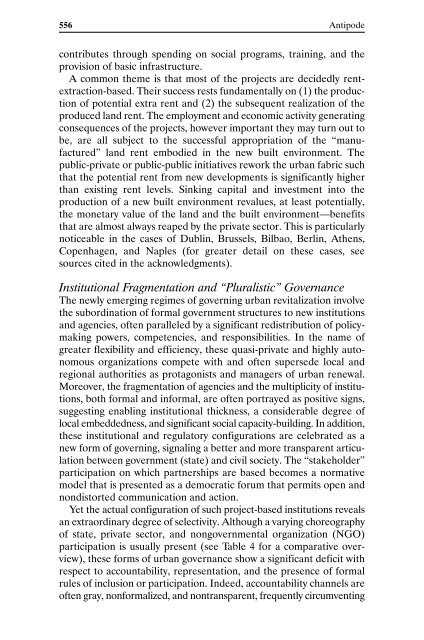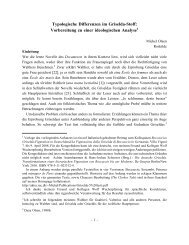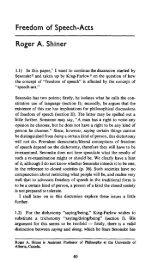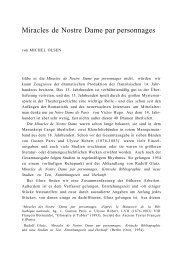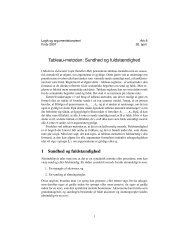Large–Scale Urban Development Projects and the New Urban Policy
Large–Scale Urban Development Projects and the New Urban Policy
Large–Scale Urban Development Projects and the New Urban Policy
Create successful ePaper yourself
Turn your PDF publications into a flip-book with our unique Google optimized e-Paper software.
556 Antipode<br />
contributes through spending on social programs, training, <strong>and</strong> <strong>the</strong><br />
provision of basic infrastructure.<br />
A common <strong>the</strong>me is that most of <strong>the</strong> projects are decidedly rentextraction-based.<br />
Their success rests fundamentally on (1) <strong>the</strong> production<br />
of potential extra rent <strong>and</strong> (2) <strong>the</strong> subsequent realization of <strong>the</strong><br />
produced l<strong>and</strong> rent. The employment <strong>and</strong> economic activity generating<br />
consequences of <strong>the</strong> projects, however important <strong>the</strong>y may turn out to<br />
be, are all subject to <strong>the</strong> successful appropriation of <strong>the</strong> “manufactured”<br />
l<strong>and</strong> rent embodied in <strong>the</strong> new built environment. The<br />
public-private or public-public initiatives rework <strong>the</strong> urban fabric such<br />
that <strong>the</strong> potential rent from new developments is significantly higher<br />
than existing rent levels. Sinking capital <strong>and</strong> investment into <strong>the</strong><br />
production of a new built environment revalues, at least potentially,<br />
<strong>the</strong> monetary value of <strong>the</strong> l<strong>and</strong> <strong>and</strong> <strong>the</strong> built environment—benefits<br />
that are almost always reaped by <strong>the</strong> private sector. This is particularly<br />
noticeable in <strong>the</strong> cases of Dublin, Brussels, Bilbao, Berlin, A<strong>the</strong>ns,<br />
Copenhagen, <strong>and</strong> Naples (for greater detail on <strong>the</strong>se cases, see<br />
sources cited in <strong>the</strong> acknowledgments).<br />
Institutional Fragmentation <strong>and</strong> “Pluralistic” Governance<br />
The newly emerging regimes of governing urban revitalization involve<br />
<strong>the</strong> subordination of formal government structures to new institutions<br />
<strong>and</strong> agencies, often paralleled by a significant redistribution of policymaking<br />
powers, competencies, <strong>and</strong> responsibilities. In <strong>the</strong> name of<br />
greater flexibility <strong>and</strong> efficiency, <strong>the</strong>se quasi-private <strong>and</strong> highly autonomous<br />
organizations compete with <strong>and</strong> often supersede local <strong>and</strong><br />
regional authorities as protagonists <strong>and</strong> managers of urban renewal.<br />
Moreover, <strong>the</strong> fragmentation of agencies <strong>and</strong> <strong>the</strong> multiplicity of institutions,<br />
both formal <strong>and</strong> informal, are often portrayed as positive signs,<br />
suggesting enabling institutional thickness, a considerable degree of<br />
local embeddedness, <strong>and</strong> significant social capacity-building. In addition,<br />
<strong>the</strong>se institutional <strong>and</strong> regulatory configurations are celebrated as a<br />
new form of governing, signaling a better <strong>and</strong> more transparent articulation<br />
between government (state) <strong>and</strong> civil society. The “stakeholder”<br />
participation on which partnerships are based becomes a normative<br />
model that is presented as a democratic forum that permits open <strong>and</strong><br />
nondistorted communication <strong>and</strong> action.<br />
Yet <strong>the</strong> actual configuration of such project-based institutions reveals<br />
an extraordinary degree of selectivity. Although a varying choreography<br />
of state, private sector, <strong>and</strong> nongovernmental organization (NGO)<br />
participation is usually present (see Table 4 for a comparative overview),<br />
<strong>the</strong>se forms of urban governance show a significant deficit with<br />
respect to accountability, representation, <strong>and</strong> <strong>the</strong> presence of formal<br />
rules of inclusion or participation. Indeed, accountability channels are<br />
often gray, nonformalized, <strong>and</strong> nontransparent, frequently circumventing


